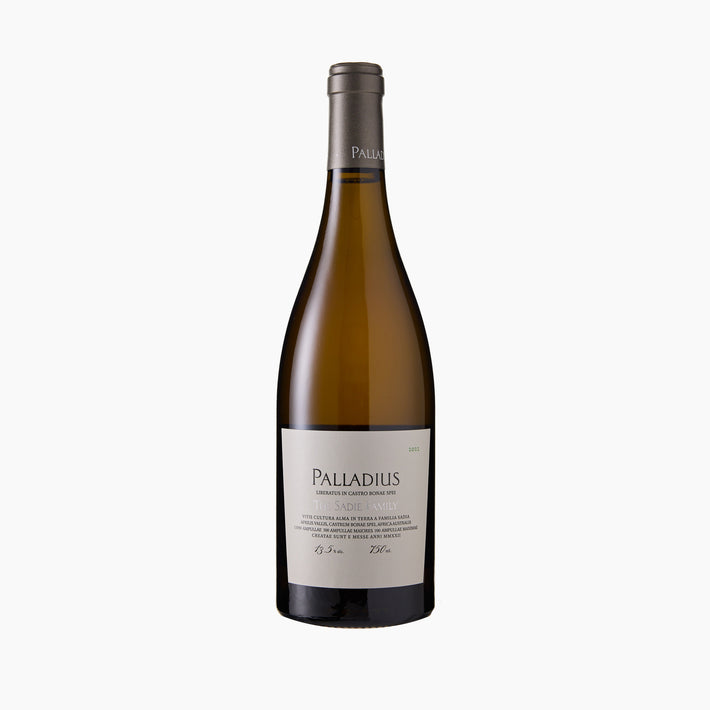Sadie, Swartland Magic!
“There is no point in analyzing every wine, as my euphoric tasting notes express how impressive his 2023 is. But I must mention the second vintage of his Chenin Blanc, the 2023 Rotsbank, which sent tingles down my spine with its nascent energy and complexity. Also, his white blend Palladius, the 2022 vintage, is the wine that Eben said he had always wanted to make and certainly the best that I have tasted.” Neal Martin, The Wine Advocate
Sadie Family Swartland 'Rotsbank' 2023
Swartland. Having coveted the site for a decade and a half, Eben finally got his hands on these 40-year-old vines in 2021. “We have always maintained that we would only bottle a Swartland Chenin if it could be from this vineyard,” Eben tells us. “It might have been a long 14 years of waiting to get our hands on this vineyard, but it was simply worth it in every respect.”
It is located in the Paardeberg and planted on a very shallow rock shelf, “Rotsbank”. This leads to minimal vine growth as the topsoil is exceptionally shallow. The reserves are always scant, and the general shoot length and bunch sizes are much smaller than in the surrounding Chenin vineyards. These early releases are clearly special, yet Eben believes there is more to come, noting: “We have spent much time and capital over the past three seasons to elevate this vineyard to the highest level, and within a year or two, we expect an even greater response from the soils.”
Cropped at 32 hl/ha and bottled at just over 13%, the new release is a frighteningly good essay in tension. The wine’s substantial acidity and mouthcoating dry finish suggest it will only benefit from the time in the bottle. It is one of the most linear expressions of the year. “It is a blue steel Chenin,” quips Sadie.
“Part of a trilogy of Chenin Blancs - and the only one from Eben Sadie's base in the Swartland - this is a brilliant second release from very bony, decomposed granite soils on the Paardeberg. Perfumed, elegant, steely and refined, it has a Grand Cru Chablis-like focus and intensity, all wet stones and oyster shell, with rock salt and fresh lime flavours and the seamless concentration of its 39-year-old bush vines.” 98 points, Tim Atkin MW, South Africa Report 2024
“The sophomore 2023 Rotsbank is the only Chenin that evolves a gunflint tincture, according to Eben Sadie. That comes through on the nose, which has more complexity than the Skurfberg this year. Pear, honeysuckle, crushed stone and light walnut scents blossom in the glass. The palate has exquisite balance and energy, real complexity and drive, and an almost penetrating finish that demands the finest oysters known to mankind. This is rapidly staking a claim to be Eben Sadie's finest wine in a stellar portfolio.” 97 points, Neal Martin, Vinous

Sadie Family Citrusdal Mountain Skurfberg Chenin Blanc 2023
Citrusdal Mountain. This extraordinary 100% Chenin Blanc hails from one of South Africa’s northernmost wine regions, the arid Citrusdal Mountain District, on the west bank of the Olifants River. Specifically, the fruit is drawn from the late Basie van Lill’s 90-year-old ungrafted bush vines at 640 metres on the decomposed, red sandstone slopes of the Skurfberg (which means ‘rigid mountain’). Planted between 1940 and 1955, these immaculately farmed vines have never been treated with herbicides or chemical fertilisers. “It is a truly great site for Chenin, and it is most unusual that such a warm and dry area still produces wines with this enormous texture and freshness,” says Eben.
Again, the Chenin is basket-pressed as bunches and transferred to old casks for spontaneous fermentation. Following 12 months on lees, the wine is blended and returned to the same casks before being bottled directly from foudre. The result is a tension-fuelled wine that can easily stand up to the greatest Chenins of the Loire—a wine of jaw-dropping texture, mineral energy and complexity. “The [2023’s] viscosity and volume, combined with the cutting acidity, suggest that this vintage has the mechanics to age incredibly well, like Kokerboom,” says Eben.
“The 2023 Skurfberg, pure Chenin on sandstone soils (which Sadie mentioned creates "earthy" whites), has a very intense nose. It’s oily and resinous with grapefruit and a touch of peach skin, very well defined but requiring time in the glass. Taut and fresh, the palate is quite lime-driven on the entry, brimming with energy from start to finish. It gently fans out toward the finish. This is a supremely gifted Skurfberg.” 95 points, Neal Martin, Vinous
“"In memory of Basie," reads the label, which is a nice tribute to the legendary grower, Basie van Lill, from whose farm Eben Sadie sources Skurfberg. Using dry-farmed grapes from a 0.8-hectare parcel on red granite and iron soils, this is pale, floral and comparatively forward for a wine from this terroir, with passion fruit, peach and lemon zest flavours and the minerality that comes with the territory on Citrusdal Mountain.” 96 points, Tim Atkin MW, South Africa Report 2024

Sadie Family Swartland 'Kokerboom' 2023
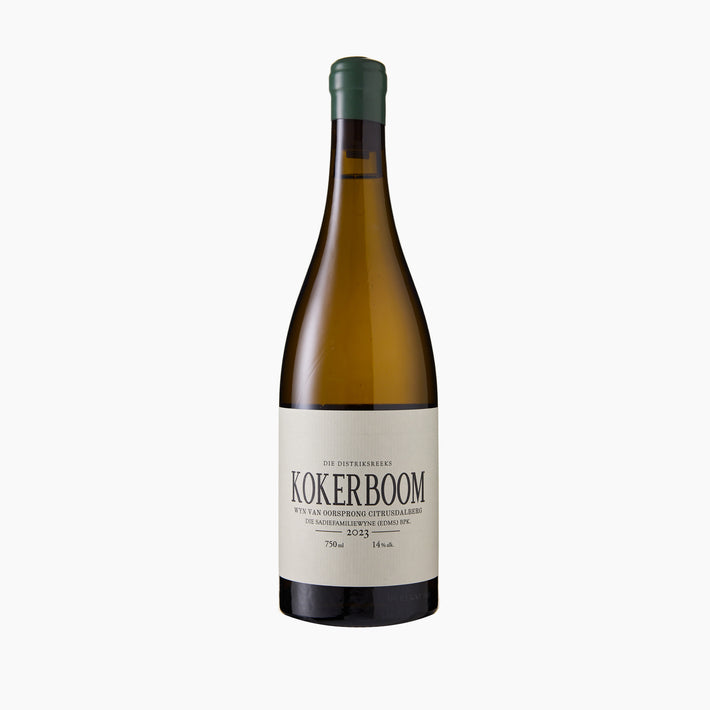
Sadie Family Swartland 'Pofadder' 2023
Old Vine Series. In the 1920s, Cinsault was the most-planted black grape in South Africa. However, as one of the fickler varieties to work with and to vinify, it suffered a fall from grace post-WWII. It’s only very recently that (with growers such as Eben Sadie and Chris Alheit leading the charge) the ‘Pinot Noir of Swartland’ has been reborn, and the results are revelatory. This variety is now being planted more and more by top growers in the south of France. Wines like this show you why.
Pofadder is pure Cinsault, cropped from a 1973-planted parcel in Riebeeksrivier on the Kasteelberg Mountain (west of Malmesbury). The soils are slate and decomposed shale. Pofadder is Afrikaans for a puff adder, a type of snake in these parts that claimed the life of a vineyard worker in the 1940s. Sadie is a champion of old-vine Cinsault in the Cape, but even he concedes that this is the vineyard and the wine that need the most care. Controlling yields, bunch/berry sorting and protection from oxidation in the cellar are all vital. Roughly 30% whole bunches are placed in an old wooden, open-top fermenter, with one or two gentle foot-stomps each day to release just enough juice to keep the fermentation ticking over. After a month on skins, the grapes are transferred to a tiny basket press and pressed directly to 28-year-old conical wooden casks for aging. The wine is a gloriously textured yet vibrant ode to variety and region. In Eben’s mind, the 2023 is the most stylish example he has released.
“Eben Sadie sources this delightful Swartland Cinsault from the Anthonij Rupert farm in Riebeeksrivier, using grapes grown on schist. Fermented with 30% whole bunches in concrete and foudres, it’s a graceful, elegant, refined expression of Cinsault with potpourri and Turkish Delight aromas, lots of zip and energy, succulent red berry fruit and granular tannins.” 96 points, Tim Atkin MW, South Africa Report 2024
“The 2023 Pofadder, 100% Cinsault planted in schist, has a floral bouquet: white flowers, rose petals, bright wild strawberry and cranberry, with a little more mineralité than the Soldaat. The palate is medium-bodied with crunchy red fruit. It’s perhaps the most tensile of any Pofadder I’ve tasted, culminating in a linear finish with life-affirming frisson. There is an effortless brilliance about this Pofadder—even better than last year's offering.” 96 points, Neal Martin, Vinous
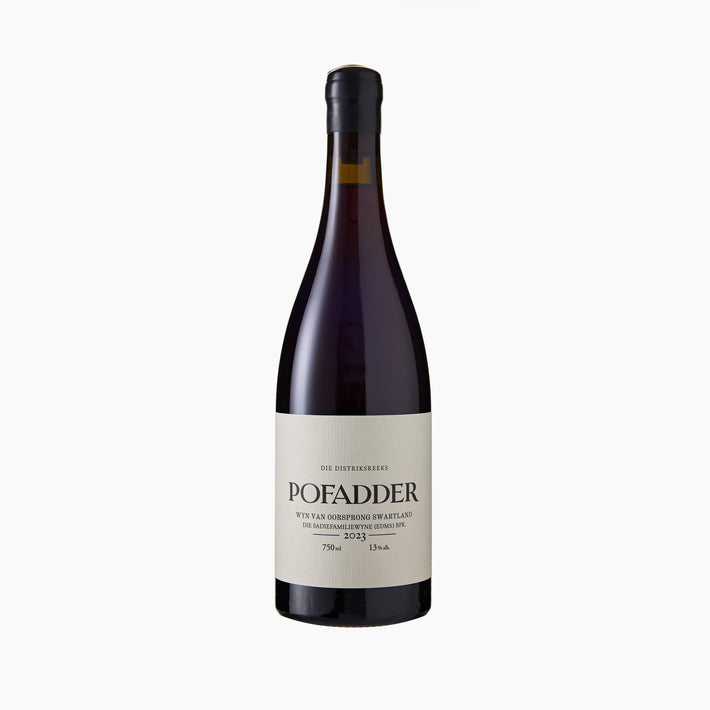
Sadie Family Swartland 'Treinspoor' 2023
Old Vine Series. “It’s a Swartland thing,” notes Sadie of Tinta Barocca (the South African spelling has only one ‘r’ and two ‘c’s). This variety arrived in South Africa from the Douro and has found an opportune home in the Western Cape. Historically, Tinta das Baroccas (as it was once labelled) has played a prominent role in Swartland’s red blends, and interest in the variety—particularly from old, dry-grown vineyards—has spiked in recent years.
This vineyard, planted in 1974 and located next to the old railway line (treinspoor), lies four kilometres west of Malmesbury on decomposed granite and sandstone. Sadie notes that while the very fragile, thin skin of Tinta Barocca is prone to sunburn, the old bush vines of this site keep the bunches sheltered from the intense Swartland sun. He likens his Treinspoor to a sort of stylistic cross between northern Rhône Syrah (black cherry/blackcurrant/grenadine fruit, iodine and nettles) and Piemontese Nebbiolo (spice, flowers, acidity and tannins). “It has Piedmont-like tannins and Northern Rhône aromatics,” says Eben. Regardless, as you can read below, it’s a brilliant red. It ferments in concrete with 50% whole bunches and is raised for 11 months in large cask. Like all Sadie wines, it is an outstanding, idiosyncratic red of beauty, finesse and character.
“The 2023 Treinspoor is pure Tinta Barocca planted on sandstone and granite/quartz. Dark berry fruit and hints of Earl Grey unfold on the nose that’s maybe just a bit Nebbiolo-like in style and very expressive. Brisk and bright, the palate is medium-bodied with slightly chalky tannins. It’s a little Barolo-like toward the grippy finish, leaving veins of blue fruit on the aftertaste. Outstanding and characterful.” 95 points, Neal Martin, Vinous
“Treinspoor is a pure Tinta Barocca from red clay soils close to Malmesbury. Eben Sadie reckons it's the "most elegant" expression of the vineyard yet, but this is still a wine that's built for the long haul, with classic damson, fig and cranberry flavours, chewy, stubble-chinned tannins, a ferrous, steak tartare undertone and enough acidity to drive and freshen the finish.” 95 points, Tim Atkin MW, South Africa Report 2024
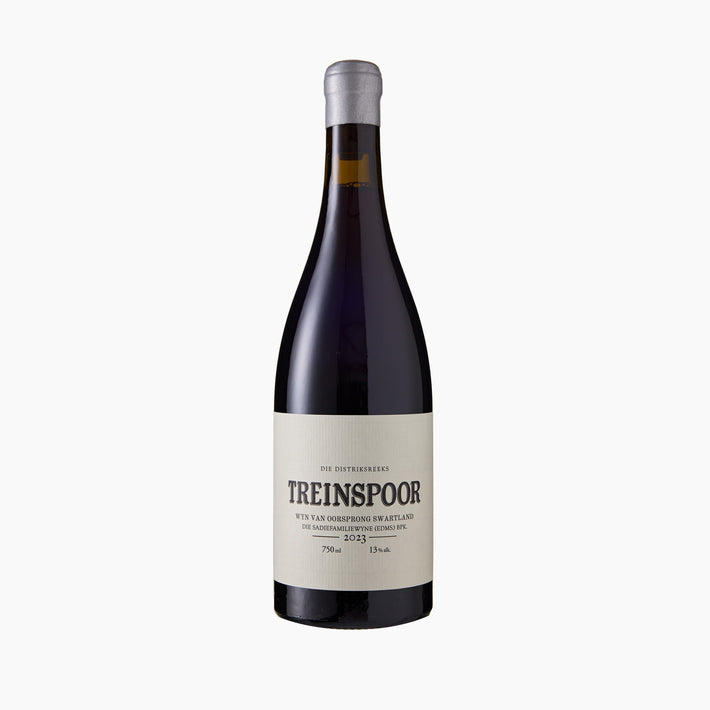
Sadie Family Swartland 'Columella' 2022
Signature wine. First released in 2000, Columella is Sadie’s most famous wine. While it’s regularly described as an icon of Swartland (and indeed South Africa), Eben Sadie’s goal is simply to produce the finest, most honest expression he can from Swartland as a whole. As such, the blend includes six of the seven official red grapes that grow in the region. The 2021 is a blend of one-quarter Syrah, with the remainder a blend of Mourvèdre, Grenache, Carignan, Tinta Barocca and Cinsault. Eben notes that the incremental growth of Mourvèdre, Carignan, Cinsault and Tinta Barocca in the final blend has contributed to the depth and complexity of tannins and that there is also more fruit purity.
Eben also wants to capture as many Swartland soils and climates as possible. This year, the grapes came from seven soil types (including granite, slate, gravel and sandstone) across 11 separate vineyards in Paardeberg, Kasteelberg, Malmesbury and Piquetberg. Most are low-yielding, old-vine parcels, although some of the estate’s younger material also plays its part. Many of the Syrah vines have been trained to their own pole (échelas style, as per northern Rhône).
Most of the fruit is destemmed, although an increasing percentage of whole bunches are used each year. Sadie has a sorting team of 25 who discard 8 to 15% of the fruit each year. The grapes go into a huge open fermenter for an average of three weeks on skins before being basket-pressed into primarily old French oak barrels (less than 5% new). After a year on lees, the wine is racked into seasoned oval casks (foudres) for further maturation on the fine lees. The wine is then bottled without fining or filtration.
A quick note on the history and evolution of this wine. The wine was a predominantly Syrah blend with Mourvèdre in its first decade. Over the years, specifically since 2009, Sadie has introduced ever-increasing amounts of the other varieties. The fruit is also picked earlier, and the winemaking has progressed. Before 2009, the style was geared towards power and extraction, maximising depth of colour, flavour and tannin. Post-2009, the maceration has become progressively gentler to the point where the cap is simply kept wet, mainly via handheld jugs. The amount of new oak has also decreased radically. It is no coincidence that these changes happened around the same time that Sadie was experimenting with similar techniques at Terroir al Límit in Priorat.
Columella is nonetheless a more powerful, complex wine than those in the Old Vine Series, with unforced intensity and a corresponding increase in texture and ripeness. We recommend decanting, and Sadie suggests a minimum of eight years in the cellar before opening. Good luck with that! The notes below tell you all about the style and brilliant quality of the 2021 release. It has the finesse, sappiness and vibrancy of great Burgundy (from a powerful year) and the depth and structure to live for decades.
“This 2021 vintage of Columella displays extremely bright red fruit aromas. The wine is incredibly fresh, and the 24 months of ageing in old casks are unmarked; it almost seems like the fruit is still hanging on the vine. Some velvety spicey herbal aromas of the bush come through on the aromatics, and then violets and perfumes follow. There are darker, deeper lines of graphite, black olive and cedarwood aromatics, and the structure of the wine is quite seamless; the tannins flow into the acidity at the end of the palate. It is incredibly balanced, and delicate layers of stitching make up this wine. Time is your friend on this one.” Eben Sadie
“The latest in a remarkable run of Columellas from Paul Jordaan and Eben Sadie, this is an eight-variety blend with Syrah taking the lead role assisted by a supporting cast of 74% Grenache, Mourvèdre, Carignan, Cinsault, Tinta Barocca, Pinotage and Alicante Bouschet. It's a Rhône Valley meets Pinot Noir style, with a combination of grace and intensity. Spicy, floral and alluring, it has aromas of incense and fynbos, detailed tannins, some meat and tapenade and the grip and focus to evolve for a decade or more in bottle.” 98 points, Tim Atkin MW, South Africa Report 2023
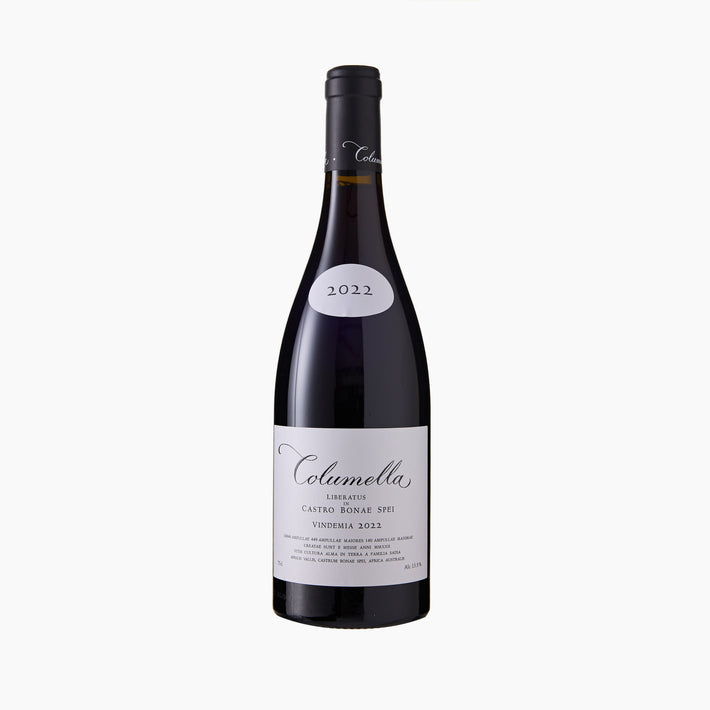
Sadie Family Swartland 'Palladius' 2022
Signature wine. Swartland. Palladius is a blend of all 11 of Swartland’s official white varieties, with old bush-vine Chenin Blanc playing the principal role. Like the Columella red, the idea is to produce a great white that represents the overall terroir of Swartland, so Sadie tries to use all permitted grapes. As a result, it is harvested from 17 sites, taking in Grenache Blanc, Clairette Blanche, Viognier, Verdelho, Roussanne, Marsanne, Semillon Blanc, Palomino and Colombard, as well as the hyper-rare Semillon Gris (which plays a starring role in Sadie’s Kokerboom and ’T Voetpad cuvées). Scattered throughout Swartland, most of the vineyards are rooted in decomposed Paardeberg granite (although four parcels lie on sandstone), and most qualify for old-vine status (35 years plus), with the oldest planted in 1935. The younger-vine fruit comes from Sadie’s own plantings, though even here, the yields max out at 30 hl/ha.
The fruit was sorted and pressed in a traditional, vertical press directly into clay amphora and concrete egg (725 litres). The wine went to large wooden foudre for maturation. The entire aging cycle is 24 months. It was bottled without fining or filtration.
Throughout the season, Sadie’s primary goal is, in his own words, “to try and get the maximum volume of compact fruit and texture together with the best potential volume of acidity and freshness.” He has unquestionably achieved that here, with the extra breadth, power and texture setting Palladius apart from his District Series whites. Palladius relies less on acidity than those, harnessing a deep, phenolic freshness that frames the wine. Eben continues: “Over the past five years, Palladius has been the wine that gained the most in quality and refinement, and much of this has to do with the addition of more vineyards and the improvement of their viticulture.” It’s a white of vast complexity; the kind you can sit with for hours. The 2022 is exquisite; the notes below capture it so well.
“The 2022 starts by almost playing hide-and-seek; the wine is more reserved and holding back. And only after warming up and a couple of minutes in the glass does the conversation start. The aromas are that of green apple and citrus flint, and then some of the stone fruit aromas begin to shine through. The wine needs time. The palate is already balanced, and the acidity is met by very firm tannins. The aftertaste is lingering. This bottling is a great vintage to follow the 2021. It is a strong contender for the most restrained version, but we must taste 2021 and 2022 with some age to have a final verdict.” Eben Sadie
“The 2022 Palladius is a blend of Chenin Blanc, Grenache Blanc, Marsanne, Roussanne, Sémillon Blanc & Gris, Palomino, Verdelho, Colombard, Clairette Blanche and Viognier from several sites. Eben Sadie says that this is the wine he has wanted to make. It has a delectable nose with wax resin, linseed oil and hints of orange blossom. The palate is well balanced with a killer line of acidity. Taut, fresh and saline, it possesses immense nervosité on the finish that lingers in the mouth. This is even better than the 2021.” 97 points, Neal Martin, Vinous
